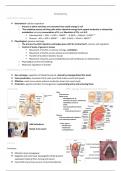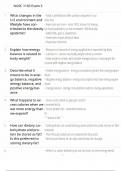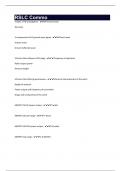Introductive lecture ................................................................................................................................ 1
Strategic entrepreneurial leadership (in AI era) ....................................................................................... 5
Organizational Level - Organizational Design ........................................................................................ 15
CSR level – Sustainable entrepreneurship, responsible organizations ..................................................... 28
,Introductive lecture
VUCA (volatile, uncertain, complex, ambiguous)
- Business cycles getting shorter
- Amount of risk firms are facing is huge → strategic risk, operational risk, ...
- Responsible behavior (i.e., Volvo)
External (macro) environment determines conditions in which businesses operate in and shapes strategies that
determine managerial practices applied to remain competitive (and create new impact)
SDG 12 → responsible production and consumption (i.e., food waste – TooGoodToGo)
1. sensing (dynamic capabilities): Ability to systematically, continuously, and reliably acquire strategically
relevant information from the environment, including market trends, best practices, and competitors’
activities, that is, information from outside the organization.
→ all about your ability to look inside insight signals from the market before it become something big.
Win-win-win business model (TooGoodToGo): helps profit, planet, people
→ remains dependent on the partners → risk of overtaking → need to scale
2. seizing (dynamic capabilities): Ability to decide whether
some information is of potential value, to transform
valuable information into concrete business opportunities
that fit the organization’s strengths and weaknesses, and to
make decisions accordingly
→ taking the risk, taking the action
→ need to scale → beside the app they are offering services
for their business partners, labeling understanding →
shipping (parcels)
1
,Three roles of managers
operational role entrepreneurial role leadership role
Responsibilities Planning and budgeting Sensing and seizing Propagating vision and value
Activities Organizing and staffing Orchestrating resources Align people with strategy
Levers Control and problem Investing in R&D, developing Motivating people
solving new business models
Goals Technical efficiency and Competitive advantage Unity of purpose
predictable results
3. transforming (dynamic capabilities): ability to adjust your internal organizational design → agile
→ AI filed by helping their partners using certain algorithms (transformed in B2B service)
→ increase in the organic structure
Shell case → leading organization in renewable energy, still they have many problems → crucial problem is
that the shareholders expect them to perform well and do not care so much about the balancing with the
“greener” business.
Role of ELROS
Help business leaders with transforming their firms into responsible organizations that continuously identify
new opportunities and create new positive impact.
2
, "Innovation, Dynamic Capabilities, and Leadership" by Paul J. H. Schoemaker, Sohvi Heaton, and David
Teece (2018) - voluntary
1. VUCA Environments: The concept of VUCA—volatility, uncertainty, complexity, and ambiguity—
originated from the U.S. military and describes conditions that challenge conventional strategic approaches.
In business, adapting to VUCA environments requires dynamic capabilities and innovative leadership to avoid
the pitfalls of traditional, rigid management styles.
2. Dynamic Capabilities: These are the abilities of an organization to integrate, build, and reconfigure internal
and external competencies to address rapidly changing environments. They include:
- Sensing Change: Detecting shifts in the external environment, such as market changes or emerging
technologies.
- Seizing Opportunities: Capitalizing on new opportunities by innovating and implementing systems that
respond to external changes.
- Transforming: Continually reshaping the organization and its business models to remain relevant and
competitive.
3. Strategic Leadership: Entrepreneurial leadership is crucial in VUCA contexts. Leaders need to develop
dynamic capabilities within their organizations, fostering a culture of innovation and agility. Key leadership
traits include the ability to anticipate changes, challenge existing norms, interpret data from multiple sources,
make decisions amidst uncertainty, align stakeholders, and learn continuously.
Examples and Case Studies
- Apple's iPod and iPhone Ecosystem: Apple leveraged its dynamic capabilities to transform from a product-
driven company to an ecosystem-focused enterprise, integrating content and technology in ways that
competitors could not easily replicate.
- Nokia’s Decline: Nokia’s failure to adapt to the digital photography market highlights the risks of clinging
to outdated business models.
- Uber’s Business Model: Uber disrupted traditional taxi services by creating a scalable, asset-light platform
that integrated drivers and customers through technology, demonstrating the importance of coherent,
innovative business models in VUCA environments.
Leadership Skills for VUCA
- Anticipate: Look for signals of change at the periphery of their industries.
- Challenge: Reframe problems and challenge current beliefs and mindsets.
- Interpret: Synthesize information from various sources to develop insights.
- Decide: Make informed decisions even when information is incomplete.
- Align: Foster open dialogue to align diverse stakeholder interests.
- Learn: Embrace feedback and view failures as learning opportunities.
Implications for Organizations: The article emphasizes that organizations must build dynamic capabilities
to adapt to VUCA conditions. This involves not only sensing and seizing opportunities but also being willing
to transform business models and operations. Strategic reframing, continuous learning, and robust leadership
are essential for long-term success.
Enel (case example)
Enel, Italy’s largest energy company, serves as an exemplary case of how a traditional utility can transform
itself to thrive in a VUCA (volatility, uncertainty, complexity, and ambiguity) environment by embracing
innovation, sustainability, and digital transformation.
Challenges:
1. Transition to Renewable Energy: Enel was originally heavily reliant on fossil fuels, which posed a risk
in the face of increasing environmental regulations, societal pressure to reduce carbon emissions, and the
global shift towards renewable energy sources.
3
Strategic entrepreneurial leadership (in AI era) ....................................................................................... 5
Organizational Level - Organizational Design ........................................................................................ 15
CSR level – Sustainable entrepreneurship, responsible organizations ..................................................... 28
,Introductive lecture
VUCA (volatile, uncertain, complex, ambiguous)
- Business cycles getting shorter
- Amount of risk firms are facing is huge → strategic risk, operational risk, ...
- Responsible behavior (i.e., Volvo)
External (macro) environment determines conditions in which businesses operate in and shapes strategies that
determine managerial practices applied to remain competitive (and create new impact)
SDG 12 → responsible production and consumption (i.e., food waste – TooGoodToGo)
1. sensing (dynamic capabilities): Ability to systematically, continuously, and reliably acquire strategically
relevant information from the environment, including market trends, best practices, and competitors’
activities, that is, information from outside the organization.
→ all about your ability to look inside insight signals from the market before it become something big.
Win-win-win business model (TooGoodToGo): helps profit, planet, people
→ remains dependent on the partners → risk of overtaking → need to scale
2. seizing (dynamic capabilities): Ability to decide whether
some information is of potential value, to transform
valuable information into concrete business opportunities
that fit the organization’s strengths and weaknesses, and to
make decisions accordingly
→ taking the risk, taking the action
→ need to scale → beside the app they are offering services
for their business partners, labeling understanding →
shipping (parcels)
1
,Three roles of managers
operational role entrepreneurial role leadership role
Responsibilities Planning and budgeting Sensing and seizing Propagating vision and value
Activities Organizing and staffing Orchestrating resources Align people with strategy
Levers Control and problem Investing in R&D, developing Motivating people
solving new business models
Goals Technical efficiency and Competitive advantage Unity of purpose
predictable results
3. transforming (dynamic capabilities): ability to adjust your internal organizational design → agile
→ AI filed by helping their partners using certain algorithms (transformed in B2B service)
→ increase in the organic structure
Shell case → leading organization in renewable energy, still they have many problems → crucial problem is
that the shareholders expect them to perform well and do not care so much about the balancing with the
“greener” business.
Role of ELROS
Help business leaders with transforming their firms into responsible organizations that continuously identify
new opportunities and create new positive impact.
2
, "Innovation, Dynamic Capabilities, and Leadership" by Paul J. H. Schoemaker, Sohvi Heaton, and David
Teece (2018) - voluntary
1. VUCA Environments: The concept of VUCA—volatility, uncertainty, complexity, and ambiguity—
originated from the U.S. military and describes conditions that challenge conventional strategic approaches.
In business, adapting to VUCA environments requires dynamic capabilities and innovative leadership to avoid
the pitfalls of traditional, rigid management styles.
2. Dynamic Capabilities: These are the abilities of an organization to integrate, build, and reconfigure internal
and external competencies to address rapidly changing environments. They include:
- Sensing Change: Detecting shifts in the external environment, such as market changes or emerging
technologies.
- Seizing Opportunities: Capitalizing on new opportunities by innovating and implementing systems that
respond to external changes.
- Transforming: Continually reshaping the organization and its business models to remain relevant and
competitive.
3. Strategic Leadership: Entrepreneurial leadership is crucial in VUCA contexts. Leaders need to develop
dynamic capabilities within their organizations, fostering a culture of innovation and agility. Key leadership
traits include the ability to anticipate changes, challenge existing norms, interpret data from multiple sources,
make decisions amidst uncertainty, align stakeholders, and learn continuously.
Examples and Case Studies
- Apple's iPod and iPhone Ecosystem: Apple leveraged its dynamic capabilities to transform from a product-
driven company to an ecosystem-focused enterprise, integrating content and technology in ways that
competitors could not easily replicate.
- Nokia’s Decline: Nokia’s failure to adapt to the digital photography market highlights the risks of clinging
to outdated business models.
- Uber’s Business Model: Uber disrupted traditional taxi services by creating a scalable, asset-light platform
that integrated drivers and customers through technology, demonstrating the importance of coherent,
innovative business models in VUCA environments.
Leadership Skills for VUCA
- Anticipate: Look for signals of change at the periphery of their industries.
- Challenge: Reframe problems and challenge current beliefs and mindsets.
- Interpret: Synthesize information from various sources to develop insights.
- Decide: Make informed decisions even when information is incomplete.
- Align: Foster open dialogue to align diverse stakeholder interests.
- Learn: Embrace feedback and view failures as learning opportunities.
Implications for Organizations: The article emphasizes that organizations must build dynamic capabilities
to adapt to VUCA conditions. This involves not only sensing and seizing opportunities but also being willing
to transform business models and operations. Strategic reframing, continuous learning, and robust leadership
are essential for long-term success.
Enel (case example)
Enel, Italy’s largest energy company, serves as an exemplary case of how a traditional utility can transform
itself to thrive in a VUCA (volatility, uncertainty, complexity, and ambiguity) environment by embracing
innovation, sustainability, and digital transformation.
Challenges:
1. Transition to Renewable Energy: Enel was originally heavily reliant on fossil fuels, which posed a risk
in the face of increasing environmental regulations, societal pressure to reduce carbon emissions, and the
global shift towards renewable energy sources.
3






